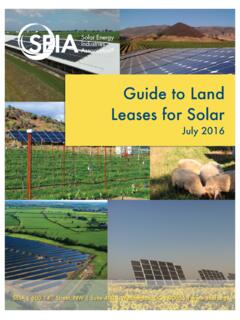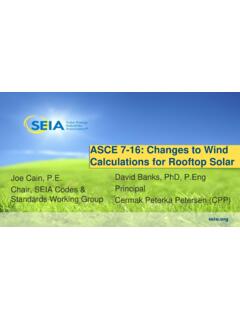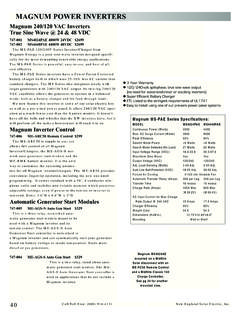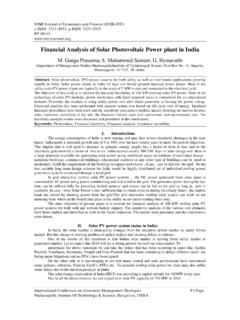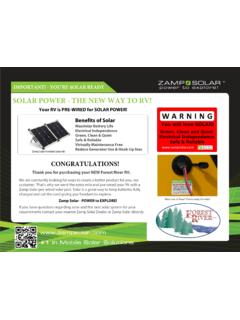Transcription of Solar Power Purchase Agreements (PPAs) - SEIA
1 1 SEIA | December 20, 2012 Host Receives Power from on-site PV system Predictable electricity prices Utility Continues to provide regular electricity service Provides net metering credit to Host customer where net metering available Developer Coordinates financing, design, and construction of PV system at Host s site Processes all incentives Monitors PV system performance Regular kWh service Excess PV kWh 10 - 25 yr. PPA Payment for electricity kWh Solar Power Purchase Agreements (PPAs) What is a Solar Power Purchase agreement ? A Solar Power Purchase agreement (PPA) is a financial agreement where a developer arranges for the design, permitting, financing and installation of a Solar energy system on a customer s property at little to no cost.
2 The developer sells the Power generated to the host customer at a fixed rate that is typically lower than the local utility s retail rate. This lower electricity price serves to offset the customer s Purchase of electricity from the grid while the developer receives the income from these sales of electricity as well as any tax credits and other incentives generated from the system. PPAs typically range from 10 to 25 years and the developer remains responsible for the operation and maintenance of the system for the duration of the agreement . At the end of the PPA contract term, a customer may be able to extend the PPA, have the developer remove the system or choose to buy the Solar energy system from the developer. Benefits of PPAs to Solar Customers No or low upfront capital costs: The developer handles the upfront costs of sizing, procuring and installing the Solar PV system.
3 Without any upfront investment, the host customer is able to adopt Solar and begin saving money as soon as the system becomes operational. Reduced energy costs: Solar PPAs provide a fixed, predictable cost of electricity for the duration of the agreement and are structured in one of two ways. Under the fixed escalator plan, the price the customer pays rises at a predetermined rate, typically between 2% - 5%. This is often lower than projected utility price increases. The fixed price plan, on the other hand, maintains a constant price throughout the term of the PPA saving the customer more as utility prices rise over time. Limited risk: The developer is responsible for system performance and operating risk. Better leverage of available tax credits: Developers are typically better positioned to utilize available tax credits to reduce system costs.
4 For example, municipal hosts and other public entities with no taxable income would not otherwise be able to take advantage of the Section 48 Investment Tax Credit. Potential increase in property value: A Solar PV system has been shown to increase residential property The long term nature of these Agreements allows PPAs to be transferred with the property and thus provides customers a means to invest in their home at little or no cost. 2 SEIA | December 20, 2012 Market Adoption and Policy PPAs provide a means to avoid the upfront capital costs of installing a Solar PV system as well as simplifying the process for the host customer. In some states, however, the PPA model faces regulatory and legislative challenges that would regulate developers as electric utilities.
5 A Solar lease is another form of third-party financing that is very similar to a PPA, but does not involve the sale of electric Power . Instead, customers lease the system as they would an automobile. In both cases, the system is owned by a third party while the host customer receives the benefits of Solar with little or no up-front costs. These third-party financing models have quickly become the most popular method for customers to realize the benefits of Solar energy. Colorado, for example, first entered the market in 2010 and by mid-2011 third-party installations represented over 60% of all residential installations and continued to rise to 75% through the first half of This upward trend is evident throughout states that have introduced third-party financing models.
6 PPA Considerations SRECs: Solar renewable energy credits (SRECs) show that a certain amount of electricity was produced using Solar energy. They are typically bought and sold by load serving entities (typically regulated utilities) to meet obligations associated with state-level renewable energy standards. SRECs are also used by consumers who voluntarily Purchase them for marketing claims or other use. Most often in PPAs , SRECs are owned by the developer. When entering into a PPA, it will be important for a customer to clearly understand who owns and can sell the SRECs generated from the PV system, the risks attendant to SREC ownership, and the tradeoffs with respect to PPA price. How to finance: While both third-party financing models provide numerous benefits, purchasing a PV system outright has its own benefits.
7 Anyone considering installing a Solar PV system should consider each of the financing options available to find the best fit. Site upgrades: While the developer is responsible for installation, operation and maintenance of a Solar PV system, the host customer may need to make investments in their property in order to support the installation of the system, lower the cost of installation or to comply with local ordinances. This might include, for example, rooftop repairs or trimming trees that shade the PV system. Possible higher property taxes: While a PV system may help to raise the site s property value, there is also a potential increase in property taxes when the property value is reassessed. Different states, however, have different policies in regards to these possible property tax increases.
8 I Berkeley National Laboratory report (2011) - ii Solar Market Insight Q2 2012 Executive Summary. About the Solar Energy Industries Association Established in 1974, the Solar Energy Industries Association is the national trade association of the Solar energy industry. Through advocacy and education, SEIA and its 1,100 member companies are building a strong Solar industry to Power America. As the voice of the industry, SEIA works to make Solar a mainstream and significant energy source by expanding markets, removing market barriers, strengthening the industry and educating the public on the benefits of Solar energy. For more information, please visit

